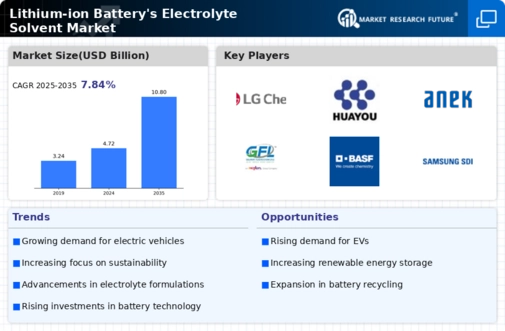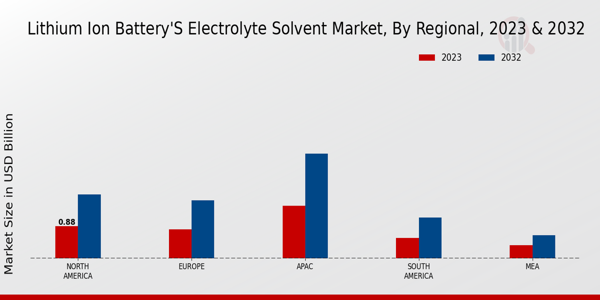Growing Renewable Energy Sector
The expansion of the renewable energy sector is significantly influencing the Global Lithium-ion Battery's Electrolyte Solvent Market Industry. As more countries invest in renewable energy sources, the need for efficient energy storage solutions becomes paramount. Lithium-ion batteries, supported by advanced electrolyte solvents, are increasingly utilized in energy storage systems to balance supply and demand. This trend is expected to contribute to the market's growth, with a projected increase from 4.72 USD Billion in 2024 to 10.8 USD Billion by 2035. The anticipated CAGR of 7.83% from 2025 to 2035 reflects the growing reliance on lithium-ion batteries for renewable energy applications.
Rising Demand for Electric Vehicles
The increasing adoption of electric vehicles (EVs) is a primary driver for the Global Lithium-ion Battery's Electrolyte Solvent Market Industry. As governments worldwide implement stricter emissions regulations and consumers seek sustainable alternatives, the demand for EVs is projected to surge. This trend is expected to significantly boost the need for high-performance lithium-ion batteries, which rely heavily on advanced electrolyte solvents. In 2024, the market is valued at 4.72 USD Billion, with projections indicating a growth to 10.8 USD Billion by 2035. Such growth reflects a compound annual growth rate (CAGR) of 7.83% from 2025 to 2035, underscoring the critical role of electrolyte solvents in battery performance and longevity.
Increasing Consumer Electronics Market
The booming consumer electronics market is a significant driver for the Global Lithium-ion Battery's Electrolyte Solvent Market Industry. With the proliferation of smartphones, laptops, and wearable devices, the demand for compact and efficient lithium-ion batteries is on the rise. These devices require high-quality electrolyte solvents to ensure optimal battery performance and longevity. As consumer electronics continue to evolve, the market for lithium-ion batteries is expected to expand, contributing to an increase in market value from 4.72 USD Billion in 2024 to 10.8 USD Billion by 2035. This growth trajectory, with a CAGR of 7.83% from 2025 to 2035, highlights the importance of electrolyte solvents in meeting consumer demands.
Regulatory Support for Battery Technologies
Regulatory frameworks supporting battery technologies are shaping the Global Lithium-ion Battery's Electrolyte Solvent Market Industry. Governments are increasingly recognizing the importance of energy storage solutions in achieving sustainability goals. Incentives and subsidies for battery production and research are likely to stimulate innovation in electrolyte solvents. As regulations evolve to promote cleaner technologies, the demand for lithium-ion batteries, and consequently their electrolyte solvents, is expected to rise. The market's growth from 4.72 USD Billion in 2024 to 10.8 USD Billion by 2035, along with a CAGR of 7.83% from 2025 to 2035, indicates the positive impact of regulatory support on the industry.
Technological Advancements in Battery Chemistry
Innovations in battery chemistry are propelling the Global Lithium-ion Battery's Electrolyte Solvent Market Industry forward. Research and development efforts are focused on enhancing the efficiency and safety of lithium-ion batteries, leading to the formulation of new electrolyte solvents that improve energy density and thermal stability. For instance, the introduction of novel solvent blends can enhance ionic conductivity, which is crucial for high-performance applications. As these advancements continue, they are likely to attract investments and drive market growth. The anticipated increase in market value from 4.72 USD Billion in 2024 to 10.8 USD Billion by 2035 indicates a robust demand for innovative electrolyte solutions.



 Source: Primary Research, Secondary Research, MRFR Database and Analyst Review
Source: Primary Research, Secondary Research, MRFR Database and Analyst Review

















Leave a Comment